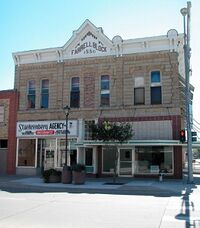Difference between revisions of "NRHP: The Farrell Block"
(Created page with "The Farrell Block (The Stone Block) ==The Farre...") |
|||
| Line 16: | Line 16: | ||
==Summary== | ==Summary== | ||
| − | The Farrell Block was designed by C. C. Rittenhouse and constructed of Colorado sandstone in 1880. It was built in Hastings as a commercial and office building by Thomas E. Farrell, an early settler and community leader. A fire destroyed half of the structure in 1953. | + | The Farrell Block was designed by [[Charles_C._Rittenhouse_(ca.1852-1937),_Architect|C. C. Rittenhouse]] and constructed of Colorado sandstone in 1880. It was built in Hastings as a commercial and office building by Thomas E. Farrell, an early settler and community leader. A fire destroyed half of the structure in 1953. |
==Further Information== | ==Further Information== | ||
Revision as of 13:42, 5 February 2018
Contents
The Farrell Block (The Stone Block)
NRHP Reference #: 79001430
NRHP Listing Date: 19790501
Location
533-537 2nd, 112 Denver Ave, Hastings, Adams County, Nebraska
View this property's location
View all NRHP properties on this map.
Summary
The Farrell Block was designed by C. C. Rittenhouse and constructed of Colorado sandstone in 1880. It was built in Hastings as a commercial and office building by Thomas E. Farrell, an early settler and community leader. A fire destroyed half of the structure in 1953.
Further Information
Bibliography
About the National Register of Historic Places
The National Register of Historic Places (NRHP) is the country’s official list of historically significant properties. To be eligible for the NRHP a property must generally retain their historic appearance, be at least 50 years old, and have the potential to be documented as historically or architecturally significant at either the local, state, or national level. The National Register of Historic Places is a National Park Service program administered by the Nebraska State Historical Society for the state of Nebraska. Visit the Nebraska State Historical Society's website to learn more about the program.
